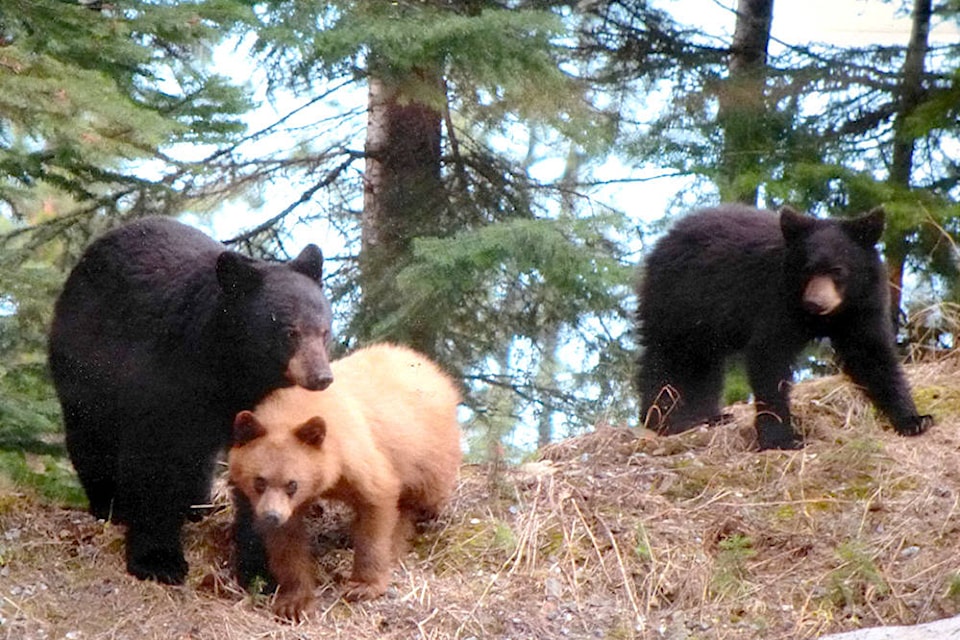Black bears are big eaters! Rightly so; these lumbering, yet agile hulks lose up to 40 per cent of their body weight while hibernating up to six months each winter (November to April).
So their waking time is spent foraging for food. Thankfully, these omnivorous opportunists, who eat everything from insect larvae, dandelions and berries to any small animal that they can easily catch, rotten fish and carrion (dead animals), don’t have people on their menu. SilverStar is the easiest place to locally spot black bears in August and September when wild strawberries, thimbleberries and especially the huckleberries are ripe.
Bears have fairly good eyesight and hearing. They have an acute sense of smell; it’s how they find food. This helps them sniff out fresh plant bulbs and roots or rodents underground as they walk by, or ripe berry patches and rotting fish kilometres away if the wind is right.
Bears are good diggers and are strong enough to push aside massive boulders, rip apart tree snags and can break into cabins or vehicles to get at food. Bears store their food as fat. All bears will aggressively defend their food sources. Boars (male bears) have established territories that they’ll savagely defend from other males. Sows (female bears) may be permitted to dine and pass through, but cubs venturing away from mom may be attacked. But when food is abundant, such as during salmon spawning, territories are ignored.
READ MORE: Bears killed after clawing way into home near Hope
Black bears inhabit all parts of B.C.’s forested lands. “Black” is a misleading name as their hair colour varies from black to brown, cinnamon (reddish), blond or even white like the Kermodes or spirit bears. Americans call them “brown bears.”
Once snow starts blanketing the earth, bears head uphill (ie. up SilverStar) for hibernation. Boars den alone, often meandering around in ever-deepening snow until they can’t easily move. Then they’ll flop down beside a log or under a tree and their body heat will create a snowcave-like air space.
Sows enter rocky dens, large hollow stumps or under log piles in late fall to hibernate. An adult sow (at least three to four years old) may give birth to two squirrel-sized cubs in January to February every second year while she snoozes. They crawl up mom’s thick fur and settle into suckling until she awakes. The little ones are puppy dog sized when they saunter out from their dens with mom in spring. She teaches them all their life skills in that first year together; how to forage, climb trees, defend themselves and hibernate. They hibernate with mom the next winter.
Once the family ventures out from hibernation they resume eating, then mom starts leaving the youngsters—now 16-17 months old—before the early summer mating season by ignoring them, chasing or shoving them away, and if that’s not enough of a hint, she’ll forcefully whack them.
These poor critters then meander around searching for food to fatten up. Heaven help them if they enter a boar’s territory. It’s these young bears that usually get into trouble with people. When attractants like garbage, bird seed, unclean barbecues or ripe fruit are around youngsters come for an easy meal. Keep enticing edibles secured away from bears. Bang on pots and pans while yelling, or use an airhorn to scare them away from your territories.
Any time we venture into the wilderness, be it a park, resort or forest, we enter bear territory. Avoid areas where bears are actively feeding. Their tracks look like chubby human footprints as they lumber flat-footed (who would be walking barefoot in the bush?) and their scats often resemble the food they’ve been eating all mushed up in black piles. Watch for freshly dug areas.
Seeing a bear in the wild is a memorable experience. Let’s keep it that way. Learn about our bears and safety precautions to keep both them and us safe from harm.
September’s part 2 will have black bear facts. Don’t miss it!
Roseanne enthusiastically shares her knowledge of the outdoors to help readers experience and enjoy nature.
